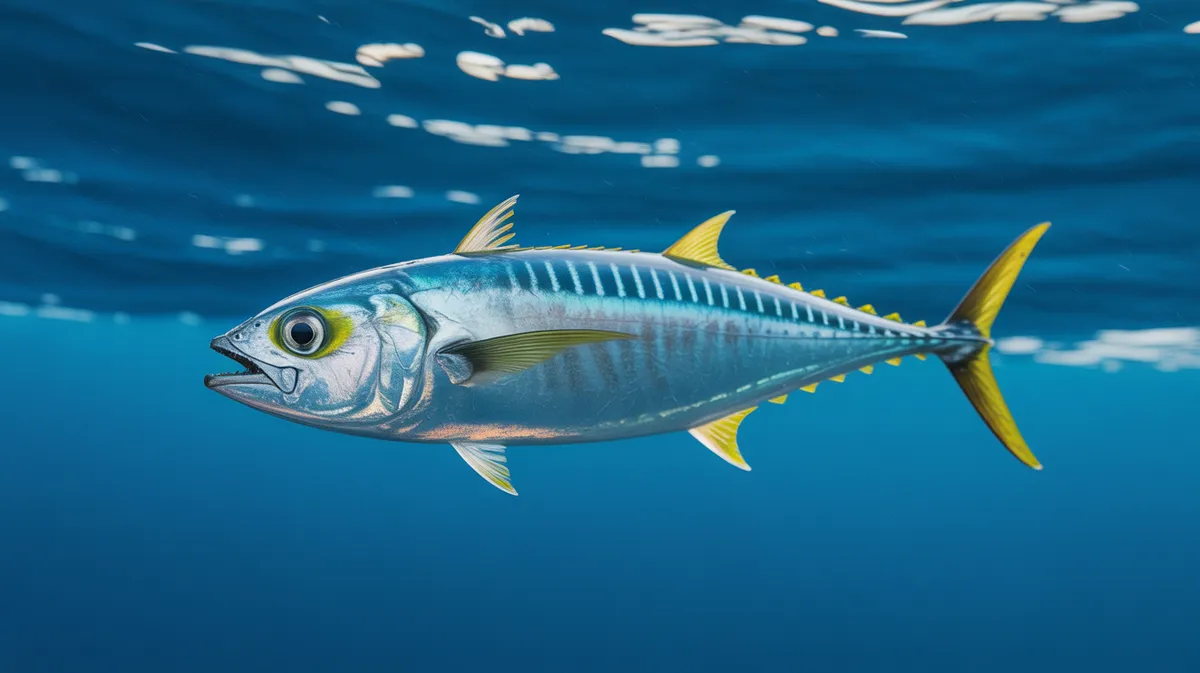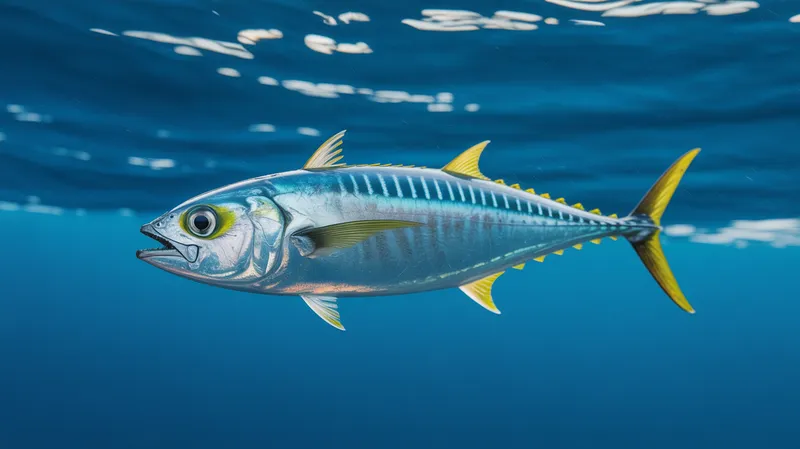
Atlantic Bonito
Sarda sarda

Meet the Atlantic Bonito
The Atlantic Bonito is a fast-swimming, predatory fish found in the warm and temperate waters of the Atlantic Ocean and the Mediterranean Sea. Recognized by its streamlined, torpedo-shaped body and distinct dark, diagonal stripes along its back, this fish is often mistaken for tuna due to its similar body shape. Atlantic Bonitos are known for their speed and agility, making them popular among sport fishers. Typically traveling in schools, they are vital predators in their ecosystem, feeding primarily on smaller fish and invertebrates.
Classification
Fish
Habitat
Coastal and offshore waters of the Atlantic Ocean and Mediterranean Sea
Diet
Carnivore
Lifespan
4-5 years
Conservation
Least Concern
Weight
2-6 kg
📖Fascinating Facts
Speedy Swimmer
Atlantic Bonitos are among the fastest fish in their range, capable of reaching impressive bursts of speed to catch prey or evade predators.
School Behavior
They are highly social and usually form large schools, especially during spawning and migratory movements.
Culinary Delight
Bonito is a prized catch for its flavorful flesh and is commonly used in Mediterranean cuisine and as 'katsuobushi' in Japanese cooking.
📋Detailed Description
The Atlantic bonito (Sarda sarda) is a robust, streamlined pelagic fish belonging to the family Scombridae. Adults typically reach lengths of 40–75 cm, with maximum recorded lengths up to 91 cm and weights up to 9 kg, though individuals over 5 kg are uncommon. Its fusiform body is built for speed, featuring a pointed snout, large mouth with sharp, conical teeth, and a deeply forked caudal fin. The dorsal side is metallic blue to dark green, adorned with 6–8 oblique, dark stripes running diagonally from the back towards the lateral line, while the ventral side is silvery white. The species has two dorsal fins separated by a small gap, followed by several finlets, a trait shared with other scombrids. Atlantic bonito are highly migratory, forming large schools that can number in the thousands, especially during feeding or spawning migrations. They are fast, agile swimmers, capable of bursts exceeding 60 km/h, which aids in both predation and predator avoidance. Their large eyes and lateral line system are well-developed, supporting their predatory lifestyle in open waters. The species is an important mid-level predator, preying on small schooling fishes such as anchovies, sardines, and mackerels, as well as cephalopods and crustaceans. Atlantic bonito play a critical ecological role in linking lower and upper trophic levels in marine food webs.
💡 Did you know?
Despite their small size compared to tunas, Atlantic Bonitos are powerful swimmers capable of making long migratory journeys across the ocean.
🔬Research & Sources
Wikipedia Summary
The Atlantic bonito is a large mackerel-like fish of the family Scombridae. It is common in shallow waters of the Atlantic Ocean, the Mediterranean Sea, and the Black Sea, where it is an important commercial and game fish.
Last Modified: 12/9/2024
🎭Behavior & Social Structure
Atlantic bonito are diurnal, exhibiting peak activity during daylight hours. They are obligate schoolers, with group cohesion providing both foraging efficiency and protection from larger predators such as tunas, sharks, and marine mammals. Schools often coordinate to herd prey fish into tight balls near the surface before launching rapid, synchronized attacks. Their feeding behavior is opportunistic and aggressive, with individuals capable of leaping from the water in pursuit of prey. Bonito are known to undertake seasonal migrations, moving northward in spring and summer to exploit productive temperate waters and returning southward or offshore in autumn and winter. They display strong homing instincts to traditional spawning and feeding grounds. Social hierarchies within schools are not well documented, but size-based segregation is observed, with juveniles and adults often forming separate groups.
👶Reproduction & Life Cycle
Spawning occurs primarily in late spring and summer (May–August), varying by region and water temperature. Atlantic bonito are batch spawners, releasing multiple clutches of pelagic eggs over the season. Females can produce between 150,000 and 2,000,000 eggs per spawning event, depending on size and age. Fertilization is external, with eggs and larvae drifting in the planktonic zone for several days before hatching. Larvae are highly vulnerable to predation and environmental fluctuations. There is no parental care; survival depends on dispersal and oceanographic conditions. Sexual maturity is typically reached at 2–3 years of age, when individuals measure around 40–45 cm in length. Spawning grounds are often located in warm, coastal waters with high productivity.
🛡️Adaptations & Survival
The Atlantic bonito exhibits several adaptations for a pelagic, predatory lifestyle. Its streamlined body minimizes drag, while a high proportion of red muscle fibers supports sustained swimming and rapid bursts of speed. The countershaded coloration provides camouflage from both prey and predators. The presence of finlets and a lunate tail enhances propulsion efficiency. Large, sensitive eyes and a well-developed lateral line facilitate detection of prey and navigation in open water. The species' schooling behavior reduces individual predation risk and increases hunting success. Physiologically, Atlantic bonito are partial endotherms, able to maintain muscle temperatures above ambient water, which improves performance in cooler waters.
📚Research Sources
🎨Cultural Significance
Atlantic bonito holds considerable cultural and economic importance in Mediterranean and Black Sea countries. It is a traditional food fish, featured in regional cuisines as 'palamut' (Turkey), 'bonito del norte' (Spain), and 'palamida' (Greece and Balkans). Historically, bonito migrations have signaled seasonal changes and influenced local fishing calendars. The species is also a popular target for sport anglers due to its fighting ability and speed. In some cultures, bonito is preserved by smoking, salting, or canning, and has been used as bait for larger tunas. While not as symbolically significant as tuna, bonito features in local folklore and culinary traditions.
🔬Recent Research & Discoveries
Recent studies have focused on Atlantic bonito's population genetics, revealing moderate genetic differentiation between Atlantic and Mediterranean populations, likely due to limited gene flow across the Strait of Gibraltar. Tagging and tracking research has improved understanding of migration routes, spawning grounds, and habitat use. Stable isotope and stomach content analyses have clarified dietary preferences and trophic roles. Fisheries science has addressed stock assessments, sustainable harvest levels, and bycatch mitigation. Ongoing research includes the effects of climate change on distribution and spawning phenology, as well as the potential for aquaculture development.
🎥Wildlife Videos

Bonito Fish facts 🐟 medium-sized, ray-finned fish–family of mackerel, tuna, butterfly kingfish.
amazinganimals facts for kids Bonitos are a tribe of medium-sized, ray-finned predatory fish – a family it shares with the mackerel, ...
Amazing Planet!

The ancestral technique for bonito fishing | SLICE
In the Societe archipelago, on the island of Huahine, bonito fishing is a man's affair. Tika Pana Pana is an extremely physical kind ...
SLICE

LEGENDS OF THE RED DUST | Tsavo’s Predators Unleashed #naturedocumentaries | Wild Nature
LEGENDS OF THE RED DUST | Tsavo's Predators Unleashed #naturedocumentaries | Wild Nature Welcome to a wild and ...
WILD NATURE - Nature animal documentary

Full Documentary | Brazil's Atlantic Forest | Wildlife of Mata Atlântica
Enjoy a full 50-minute documentary about Brazil's Mata Atlântica! "Brazil – A natural History" Part 1: FRAGILE FOREST ...
Terra Mater

Croatia's Secret Animal Paradise | Free Documentary Nature
Croatia's Secret Animal Paradise | Nature Documentary Watch 'Wild Germany: The Mecklenburg Lake Plateau' here: ...
Free Documentary - Nature

Wild Colombia - Fantastic Creatures | The Lost Eden | Free Documentary Nature
Wild Colombia - Fantastic Creatures | The Lost Eden | Free Documentary Nature Watch 'Wild Colombia Revealed' here: ...
Free Documentary - Nature
🌍Habitat Information
The Atlantic Bonito typically inhabits Coastal and offshore waters of the Atlantic Ocean and Mediterranean Sea environments. Atlantic Bonitos have adapted to their environments with specialized features and behaviors.
Primary Habitat:
Coastal and offshore waters of the Atlantic Ocean and Mediterranean Sea
More detailed habitat information will be available soon.
🛡️Conservation Status
The Atlantic Bonito is currently classified as Least Concern. Conservation efforts are crucial for preserving this species for future generations.
Common Threats:
- 🏠Habitat loss and fragmentation
- 🌡️Climate change impacts
- 🎯Hunting and poaching
- 🏭Human-wildlife conflict
⚠️Threats & Conservation Challenges
Currently assessed as Least Concern by the IUCN, Atlantic bonito populations are considered stable, though localized declines have been reported in some regions due to overfishing and habitat degradation. The species is targeted by commercial and recreational fisheries, especially in the Mediterranean and Black Seas, where it is valued for its flesh. Bycatch in other pelagic fisheries and unregulated artisanal fishing pose additional pressures. Environmental changes, such as warming sea temperatures and shifts in prey availability, may impact future population dynamics. There is limited evidence of significant pollution or disease threats, but ongoing monitoring is recommended to detect emerging risks.
🔬Scientific Classification
Scientific Name
Sarda sarda
Classification Hierarchy
🔍 About Taxonomic Classification
Taxonomic classification is a hierarchical system used by scientists to classify and organize living organisms based on shared characteristics and evolutionary relationships.
The system moves from broad categories (Kingdom) to increasingly specific ones, with each animal's scientific name typically consisting of its Genus and species.
📝Community Notes
Share your observations and insights about the Atlantic Bonito with our community of wildlife enthusiasts.
Join Our Community
Sign in to share your observations and connect with fellow wildlife enthusiasts.
Sign In to ContributeNo community notes yet
Be the first to share your observations about the Atlantic Bonito!
Explore Atlantic Bonito
Select a tab above to learn more about this amazing animal.
📸Photo Gallery
No photos available for this animal yet.
🌟Discover More Wildlife
Continue your journey of discovery with more fascinating animals from our database
